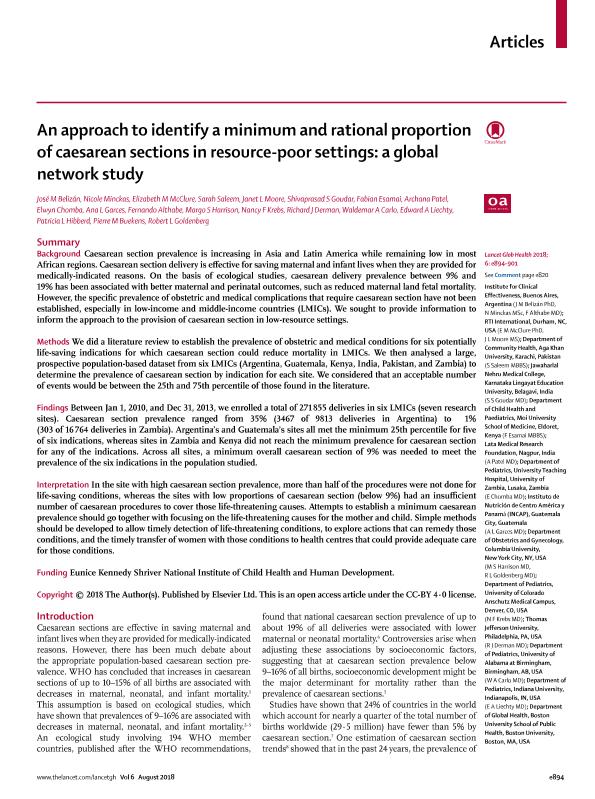Artículo
An approach to identify a minimum and rational proportion of caesarean sections in resource-poor settings: a global network study
Belizan, Jose ; Minckas, Nicole; McClure, Elizabeth M.; Saleem, Sarah; Moore, Janet L.; Goudar, Shivaprasad S.; Esamai, Fabian; Patel, Archana; Chomba, Elwyn; Garces, Ana L.; Althabe, Fernando
; Minckas, Nicole; McClure, Elizabeth M.; Saleem, Sarah; Moore, Janet L.; Goudar, Shivaprasad S.; Esamai, Fabian; Patel, Archana; Chomba, Elwyn; Garces, Ana L.; Althabe, Fernando ; Harrison, Margo S.; Krebs, Nancy F.; Derman, Richard J.; Carlo, Waldemar A.; Liechty, Edward A.; Hibberd, Patricia L.; Buekens, Pierre M.; Goldenberg, Robert L.
; Harrison, Margo S.; Krebs, Nancy F.; Derman, Richard J.; Carlo, Waldemar A.; Liechty, Edward A.; Hibberd, Patricia L.; Buekens, Pierre M.; Goldenberg, Robert L.
 ; Minckas, Nicole; McClure, Elizabeth M.; Saleem, Sarah; Moore, Janet L.; Goudar, Shivaprasad S.; Esamai, Fabian; Patel, Archana; Chomba, Elwyn; Garces, Ana L.; Althabe, Fernando
; Minckas, Nicole; McClure, Elizabeth M.; Saleem, Sarah; Moore, Janet L.; Goudar, Shivaprasad S.; Esamai, Fabian; Patel, Archana; Chomba, Elwyn; Garces, Ana L.; Althabe, Fernando ; Harrison, Margo S.; Krebs, Nancy F.; Derman, Richard J.; Carlo, Waldemar A.; Liechty, Edward A.; Hibberd, Patricia L.; Buekens, Pierre M.; Goldenberg, Robert L.
; Harrison, Margo S.; Krebs, Nancy F.; Derman, Richard J.; Carlo, Waldemar A.; Liechty, Edward A.; Hibberd, Patricia L.; Buekens, Pierre M.; Goldenberg, Robert L.
Fecha de publicación:
08/2018
Editorial:
Elsevier
Revista:
The Lancet Global Health
ISSN:
2214-109X
Idioma:
Inglés
Tipo de recurso:
Artículo publicado
Clasificación temática:
Resumen
Background: Caesarean section prevalence is increasing in Asia and Latin America while remaining low in most African regions. Caesarean section delivery is effective for saving maternal and infant lives when they are provided for medically-indicated reasons. On the basis of ecological studies, caesarean delivery prevalence between 9% and 19% has been associated with better maternal and perinatal outcomes, such as reduced maternal land fetal mortality. However, the specific prevalence of obstetric and medical complications that require caesarean section have not been established, especially in low-income and middle-income countries (LMICs). We sought to provide information to inform the approach to the provision of caesarean section in low-resource settings. Methods: We did a literature review to establish the prevalence of obstetric and medical conditions for six potentially life-saving indications for which caesarean section could reduce mortality in LMICs. We then analysed a large, prospective population-based dataset from six LMICs (Argentina, Guatemala, Kenya, India, Pakistan, and Zambia) to determine the prevalence of caesarean section by indication for each site. We considered that an acceptable number of events would be between the 25th and 75th percentile of those found in the literature. Findings: Between Jan 1, 2010, and Dec 31, 2013, we enrolled a total of 271 855 deliveries in six LMICs (seven research sites). Caesarean section prevalence ranged from 35% (3467 of 9813 deliveries in Argentina) to 1% (303 of 16 764 deliveries in Zambia). Argentina's and Guatemala's sites all met the minimum 25th percentile for five of six indications, whereas sites in Zambia and Kenya did not reach the minimum prevalence for caesarean section for any of the indications. Across all sites, a minimum overall caesarean section of 9% was needed to meet the prevalence of the six indications in the population studied. Interpretation: In the site with high caesarean section prevalence, more than half of the procedures were not done for life-saving conditions, whereas the sites with low proportions of caesarean section (below 9%) had an insufficient number of caesarean procedures to cover those life-threatening causes. Attempts to establish a minimum caesarean prevalence should go together with focusing on the life-threatening causes for the mother and child. Simple methods should be developed to allow timely detection of life-threatening conditions, to explore actions that can remedy those conditions, and the timely transfer of women with those conditions to health centres that could provide adequate care for those conditions. Funding: Eunice Kennedy Shriver National Institute of Child Health and Human Development.
Palabras clave:
caesarean
,
resource-poor settings
,
global network study
Archivos asociados
Licencia
Identificadores
Colecciones
Articulos(CIESP)
Articulos de CENTRO DE INVESTIGACIONES EN EPIDEMIOLOGIA Y SALUD PUBLICA
Articulos de CENTRO DE INVESTIGACIONES EN EPIDEMIOLOGIA Y SALUD PUBLICA
Citación
Belizan, Jose; Minckas, Nicole; McClure, Elizabeth M.; Saleem, Sarah; Moore, Janet L.; et al.; An approach to identify a minimum and rational proportion of caesarean sections in resource-poor settings: a global network study; Elsevier; The Lancet Global Health; 6; 8; 8-2018; e894-e901
Compartir
Altmétricas



